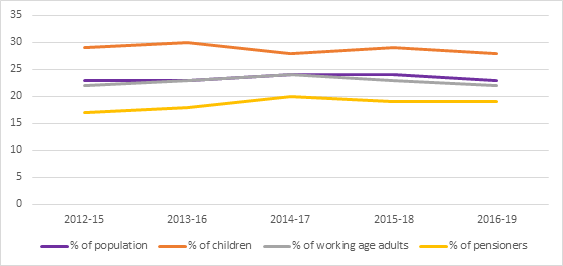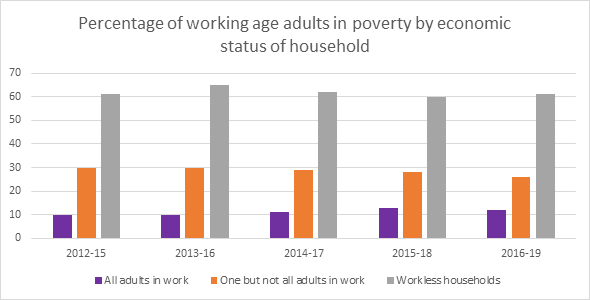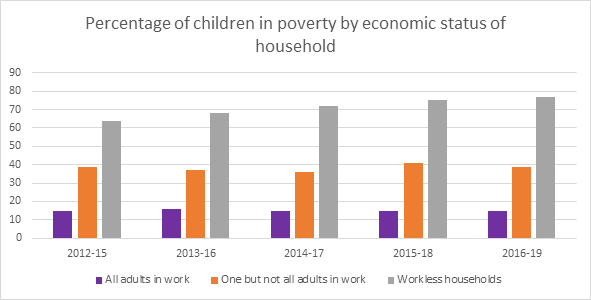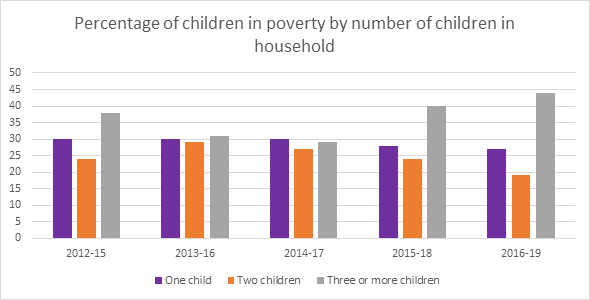 Poverty
Poverty 
On the 26th of March the latest poverty statistics were published. Steffan Evans takes a look to say what they tell us about the state of Wales in the run up to the Covid 19 crisis.
The Covid 19 crisis has had a dramatic impact on all our lives. As has been highlighted in a series of blogs on our website throughout this week however, this impact on some of the poorest and most vulnerable people within our society is likely to be more pronounced. The publication of the latest poverty statistics on the 26th of March gives us an insight into the state of Wales entering the crisis.
Poverty statistics are published annually in Wales, but the data released is the average for the previous three years. This means there are some limitations to the data. Perhaps the most significant limitation is that it evens out the impact of policy decisions or events, making it hard to measure the effectiveness of actions to solve poverty in the immediate term. Over the longer term. however, it is a vital source of data allowing us to see whether we are heading in the right direction.
The latest data is cause for cautious optimism.
The overall poverty rate in Wales has reduced from 24% to 23%, with similar reductions to be seen in the percentage of children (29% to 28%) and working age adults (23% to 22%) living in poverty, whilst pensioner remains unchanged at 19%.
These are relatively small fluctuations, and looking back over the data for the past five years shows a more mixed picture.
Chart 1 – The percentage of people living in relative income poverty by age group

Source: Stats Wales, Percentage of all individuals, children, working-age adults and pensioners living in relative income poverty, available at – https://statswales.gov.wales/Catalogue/Community-Safety-and-Social-Inclusion/Poverty/householdbelowaverageincome-by-year
The overall poverty rate in Wales in unchanged since 2012-15, with the poverty rate remaining pretty steady along this whole period. Whilst this indicates that the situation isn’t deteriorating in Wales, it also suggests that things aren’t necessarily getting better either.
Looking beneath the bonnet there appear to be some particularly interesting trends emerging with regards to families and work.

Source: Stats Wales, Working age adults in relative income poverty by economic status of household, available at – https://statswales.gov.wales/Catalogue/Community-Safety-and-Social-Inclusion/Poverty/workingageadultsinrelativeincomepoverty-by-economicstatusofhousehold
For the third period in a row the number of working age adults living in poverty has reduced in households where one but not all adults are in work. This suggests that some progress is being made in reducing poverty in such households. Whilst the poverty in workless households has fluctuated over the past five years, the poverty rate in households where all working age adults are in work, remains on an upward trajectory. The percentage of working age adults living in poverty in such households needs to reduce by 2 percentage points to return to 2013-16 levels.
Interestingly the picture is different when looking at child poverty by economic activity of the household.

Source: Stats Wales, Children in relative income poverty by economic status of household, available at https://statswales.gov.wales/Catalogue/Community-Safety-and-Social-Inclusion/Poverty/childreninrelativeincomepoverty-by-economicstatusofhousehold
For children, poverty is increasing in workless households rather than households where all adults are in work. Each of the past five years has seen a dramatic increase in the percentage of children living in poverty in such households.
The other group that has seen a significant increase in the poverty rate is households with three or more children.

Source: Stats Wales, Children in relative income poverty by number of children in the household available at https://statswales.gov.wales/Catalogue/Community-Safety-and-Social-Inclusion/Poverty/childreninrelativeincomepoverty-by-numberofchildreninthehousehold
Whilst there has been a downward trend in the proportion of children living in poverty in one and two child families, the past two years have seen a significant spike in the number of children living in poverty in larger families. This is a trend that is also reflected for working age adults that have children. One reason for this large spike is likely to be the introduction of the two child limit on benefits. This may also explain why child poverty is increasing in workless households, given such families are likely to be more dependent on the benefits that they receive.
What does the data mean for Wales in the current climate?
Whilst it is reassuring that the latest data does not suggest that poverty is worsening in Wales, it is clear that too many people are still locked in poverty. These people are likely to be the worst hit by the Covid 19 virus, having less access to savings, finding it harder to comply with self isolation guidance, and being more likely to have underlying health conditions. Whilst there is an immediate need to assist households in poverty in the current crisis, it is vital that UK and Welsh Governments take longer term steps to release the grip of poverty on Wales, once and for all.


